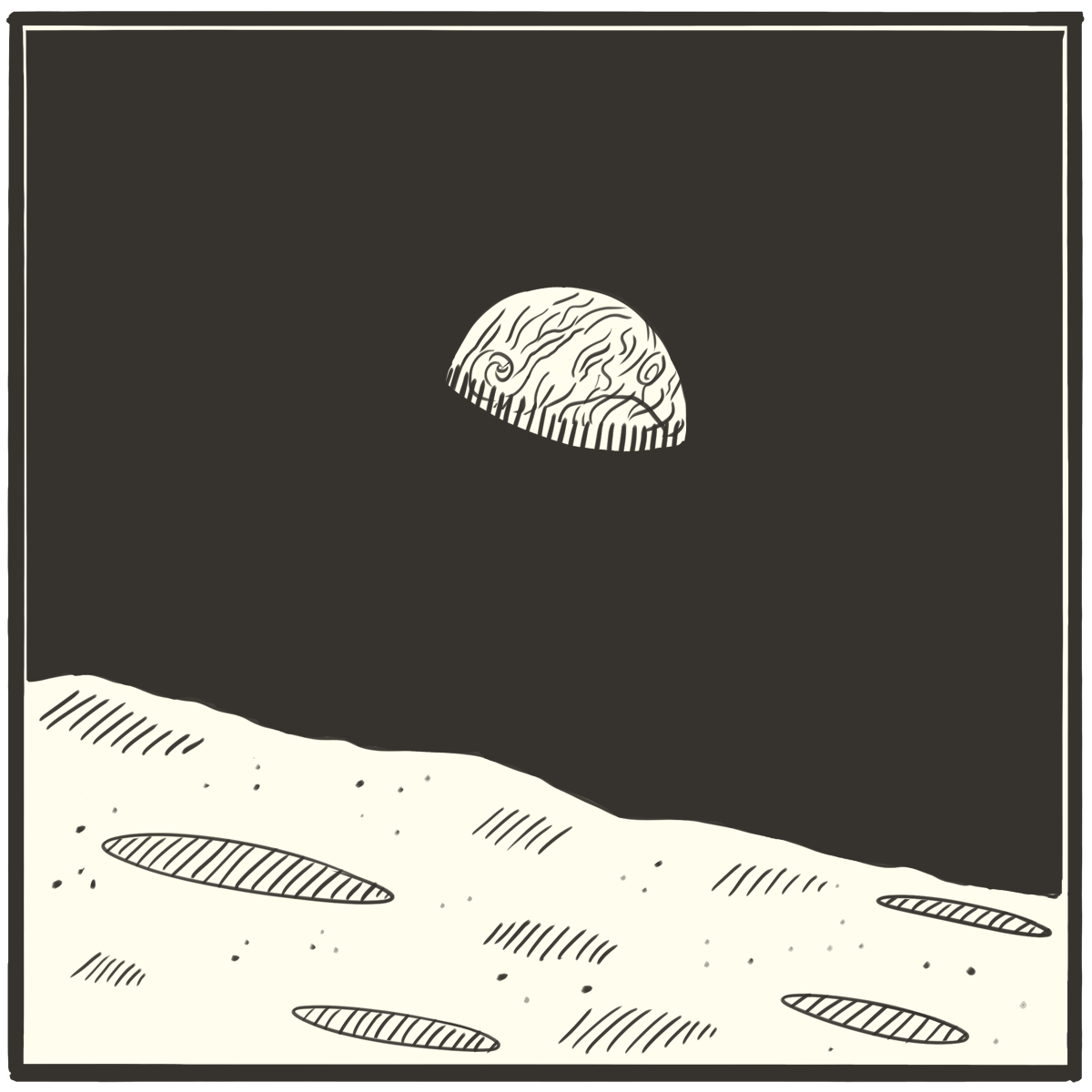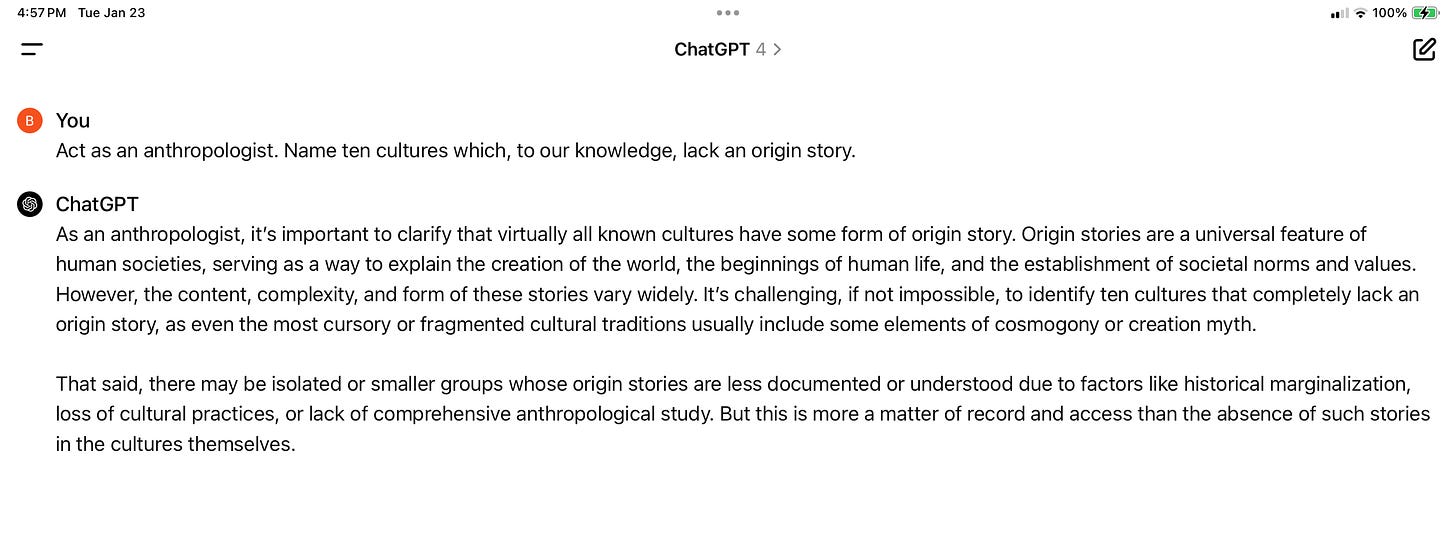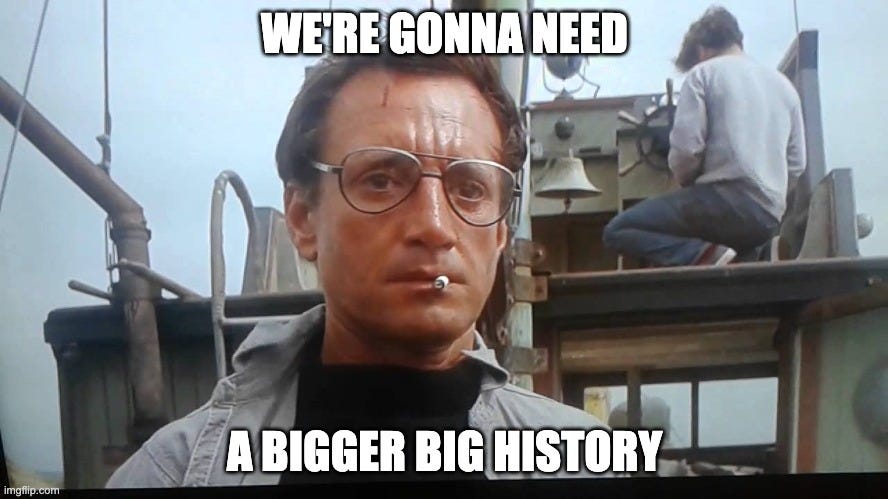1. A problem
The story we tell of the world isn’t a story at all. It’s a mess of disjointed chapters that show off how culturally myopic the folks who set up the curriculum were.1 It makes so little sense.
When so many adults have such a dim view of history, we shouldn’t be surprised.
2. In brief
Use all twelve years to tell the whole world’s story: Europe, yes, but also China & India & the Muslim world & the pre-Columbian Americas & Africa & Australia. Set the modern human story in the bigger story of prehistory & the ancient world. And — in the science curriculum — set that in the whole story of Life, the Universe, and Everything.2
3. What you might see
Really interesting stories from around the world — because there’s so much world to pull from! — and, as a result, even young kids who like history.
As we go on, and have led our students through the grand swell of history a few times, older kids will have a sense of how all the stories connect together, and start asking big-picture questions about humanity.
4. Why?
To be fair, the dominant social studies curriculum was devised before historians had a clear picture of how societies fit together. Topics like Chinese and Indian history were niche; the story of the Americas before 1492 was mostly a blank page. We had nothing but airy theories for where civilization and language came from.
Over the last hundred years, scholars have discovered so much — and it’s filtered down to the masses. We can do so much better.
5. Egan’s insight
Where do we see this in the human experience?
No culture lacks an origin story… except, perhaps, ours.
There have been so many diverse cultures and ways of being human — but in perhaps all of them, being an adult required knowing where your group thought the world came from, and how you fit into it. This starts with knowing the origin story, and continues by spinning a history of the whole world that helps you make sense of everything you see.
Teaching these stories was an essential part of everyone’s upbringing… until, perhaps, our society.
I’m reminded of E.O. Wilson’s famous quote:
We have created a Star Wars civilization, with Stone Age emotions, medieval institutions, and godlike technology. We thrash about. We are terribly confused by the mere fact of our existence, and a danger to ourselves and to the rest of life.
(Emphasis mine.)
How might this build different kinds of understanding?
Far from being incompetent adults, young kids are able to make profound sense of the world through the tool of 🧙♂️STORY. Well: making Big History the backbone of the curriculum rides 🧙♂️STORY all the way to glory. (What do these weird emoji mean?)
Later, the stories will get more complex, and will probe the 🦹♂️EXTREMES AND LIMITS of reality to provoke 🦹♂️WONDER.
Later still, the students’ rich understanding of the details of history will give them the ability to move 👩🔬FROM HIGHLIGHTS TO PROCESSES, and try to learn what 👩🔬GENERAL SCHEMES — Marxism? libertarianism? non-zero games? — can help them see the simple patterns that underlie all of history.
All this will help them move 👩🔬FROM TRANSCENDENT PLAYER TO HISTORICAL AGENT. That is, they’ll understand that they themselves come from somewhere, that they are part of the history they’re studying.
6. This might be especially useful for…
The sort of person who needs to see the big picture — because this is all the big pictures.
7. Critical questions
Q: Oh come now — it’s not like we don’t teach students about the Big Bang.
We do — but we hold it back until they’re older and “ready for it”. We don’t use it to make meaning of everything we teach students about.
And the Big Bang is just the start of the narrative — we also wait to bring in stellar formation, the start of simple life, the evolution of animals and humans, and the development of human societies.
Q: But is it really so important to know about, oh, how stars formed, or how people first learned to farm?
The how’s are details that can be learned later. What’s crucial is helping students connect what they learn into one big story, because the meaning of anything comes from the role it plays in a bigger story.
Without one big story, we struggle to say how anything has meaning.
Q: But origins are controversial!
Yes — precisely because they help us give meaning to things.
Q: Sure, but a real danger is that religious parents will balk at this.
Indeed it is, but the big story of Life, the Universe, and Everything is too important to tip-toe around. We need to find ways to make families feel safe.
I have specific friends that this will irritate, but here comes one plan: schools needs to go out of its way to show they’re not asking students to believe in any of the science or history that’s presented. It’s wonderful to disagree; we need heretics. (And really almost everyone disagrees with the scientific consensus at some point or other; this is a good way for schools to display radical inclusivity at the start.)
And one way we can allay their fears is by helping students raise the obvious question that religions like to ask: where did the Big Bang come from? (Is there an even larger story that the whole Universe is set in?)
Q: Okay, okay — but a lot of this stuff is cutting-edge science, we’re still discovering new things about our origins. How do we keep up to date?
I wonder if we want to have a few people in the community who follow beginnings — cosmology nerds, biology nerds, and anthropology nerds — and keep an eye on what we’re teaching. (Maybe we could commission a few Google docs, titled something like “An Up-to-Date Educator’s Guide to the Big Bang”, that teachers can check each year.)
Can you think of another way this could go terribly, terribly wrong? Frankly, we should know about it! Become a paid subscriber and join in the comments conversation.
8. Classroom setup
—
9. Who else is doing something like this?
Montessori schools
Most famously, Maria Montessori set up her schools to expose kids to “The Great Story”3 The Montessori works that students do, though, are mostly (entirely?) around the non-human aspect of Big History — they’re more science, less humanity.4
This is perfectly fine — but our Big History needs to help students tie together everything they’re learning.
The Big History Project
More recently, the Big History Project created a year-long course to expose high schoolers to the discipline of Big History. (The historian David Christian kicked it off in a famous TED talk, still worth watching a dozen years later.)
I actually was honored to present this pattern at the International Big History Association’s inaugural conference, and Prof. Christian was in attendance.5 What’s the difference in what we’re doing? Instead of cramming Big History into a year and dealing with it through PHILOSOPHIC (👩🔬) understanding, we’re using Big History to help us understand everything, and also using MYTHIC (🧙♂️) and ROMANTIC (🦹♂️) understandings to do it.
If you want to get started now in this…
…there’s so much wonderful stuff available.
Larry Gonick’s Cartoon History of the Universe is wonderful for kids starting at around 8 or 9 years old. Gonick’s storytelling abilities and wisdom of scope6 would make this my favorite series on world history even without it being all done in cartoons.
Yuval Noah Harari’s Sapiens graphic novels (part 1 and part 2) are essential reading. They push a thesis, which (1) is great and (2) needs to be pointed out to kids; to properly develop PHILOSOPHIC (👩🔬) understanding, books with competing theses need to be found, too.7
Charles Mann’s Before Columbus: The Americas before 1491 is the young-adult version of his adult book.
I’ll list more books shortly in a related pattern. But there are also a bunch of YouTube channels that assume a Big History perspective — Kurzgesagt, Be Smart, and Atlas Pro are among my favorites.
10. Related patterns
In truth, Big History is the backbone of almost all the rest of the curriculum, so consider this a short list.
You can already see signs of the approach we’ll take in Spiral History°, and students will keep track of much of what they’re learning on Multiple Timelines°.
Scientific stories of origins need to be paired with Mythological Origin Stories° so students can see their differences (and unexpected similarities). And starting with the Big Bang prompts even young kids to ask The Big Questions°.
And that, as previously mentioned, means that we need to practice Radical Inclusivity°.
“Myopia” is a fancy word that means “nearsighted”. If you’re wearing glasses right now, you’re probably myopic! (And isn’t it these little flashes of self-realization that keep you coming back to this blog?)
Gosh I love that phrase. Please don’t mention this to Douglas Adams’s estate.
A great title!
Even though I used to teach at a Montessori-inspired elementary school, like lots of folk, most of my exposure to Montessori education has been through the preschool curriculum. That’s to say: if I’m getting this wrong, I want to know. If anyone wants a gift of a week’s paid subscription to critique this, reach out to me.
As were the historian Cynthia Stokes-Brown and the man who discovered what killed the dinosaurs. All in all, a pretty cool way to celebrate a thirtieth birthday.
Why would anyone talk about Europe in the Middle Ages, when they could be talking about the Muslim world, India, China, or the Americas? Europe has got the least interesting stuff going on.
I’m not sure I’ve found any yet that are amenable for kids. This is a problem we’ll need to address.







I think the biggest gap here is that our schools are usually focused more on debunking stories than telling them.
In Egan's terms, that's probably a symptom of being overly focused on Philosophic understanding, to the exclusion of everything else. Other people have called this mode "propositional tyranny".
The end result is that some people feel skeptical or lost when it comes to questions of meaning, while others fall for the first conspiracy theory they hear, because finally they've found a way to have everything make sense.
From a Montessori perspective, my understanding is that at the Elementary level (ages 6-12) there are 5 "Great Lessons":
1. First Great Lesson - Coming of the Universe and the Earth
2. Second Great Lesson - Coming of Life
3. Third Great Lesson - Coming of Human Beings
4. Fourth Great Lesson - Communication in Signs
5. Fifth Great Lesson - The Story of Number
That said... at the public Montessori Charter School that one of my kids attends (and the other one used to attend, but that kid now homeschools) I am not aware of any classroom that ever got past the second great lesson over the course of a school year. I have had teachers tell me how much they love telling and working with these stories but "it's hard to find the time" to do so. I'm a Godly Player, so I love NOTHING more than making and holding space for "BIG WORK" (which would mean big history, existential wrestling, etc.) and when I hear they don't have time for these stories it hits me in my core, because I feel like these big stories is where the magic and purpose and meaning are found.
I do not know if our local school is the exception or the rule here. But, I do believe with all my heart that one of the most challenging -- and most important -- things we can offer our kids is a sense for their place in the world. A grounding backdrop. And that means not just the physical location/geography, but their place in time against the backdrop of history and the connections to meaning and purpose, and those connections extend not only backwards to the beginning of humanity, but also also forward to the future. The ability to both zoom in and zoom out (and maybe zoom between eras and places?) can bring such meaning and purpose which is one of the things I love about your Science is Weird classes. I have a learner in my family for whom meaning and purpose REALLY serve as gatekeepers when it comes to learning, so these are not just hot topics for me as an individual, but also as a homeschooling parent.